0968
Quantitative assessment of left and right atrial strains using cardiovascular magnetic resonance based tissue tracking
Yang-yang Qu1,2, Dominik Buckert1, and Volker Rasche1
1Internal Medicine II, Ulm University, Ulm, Germany, 2Department of Cardiology, Zhongda Hospital, School of Medicine, Southeast University, Nanjing, China
1Internal Medicine II, Ulm University, Ulm, Germany, 2Department of Cardiology, Zhongda Hospital, School of Medicine, Southeast University, Nanjing, China
Synopsis
To better understand the mechanics of left and right atrium, radial and longitudinal strains of atrial free wall was quantified using cardiovascular magnetic resonance based tissue tracking (CMR-TT) technique. Gender- and age-specific reference values were generated among a healthy population (n=150). Larger magnitudes of strains were noticed in females and the younger. CMR-TT has been proven as a feasible and reproducible technique in this study, and the gender- and age-specific references need to be established for the clinical practice.
Introduction
Left and right atrium (LA and RA) exert an essential and dynamic role in ventricular filling and hence affect heart performance. Strain has been reported as a novel marker to reflect atrial function. However, the establishment of bi-atrial strains with CMR based techniques are still limited. Hence, we aimed to describe a novel approach to quantify atrial strains and generate gender- and age-specific reference values in a large healthy population.Methods
150 healthy volunteers (49.8 ± 17.3 years, 75 males) undergoing 1.5 Tesla CMR examination were retrospectively and consecutively recruited. Reservoir, conduit and pump LA and RA free wall (RAFW) radial and longitudinal strains (RS and LS) were evaluated with CMR-TT technique (Figure 1).Results
The reservoir, conduit and pump LS resulted as 30.7 ± 10.2%, 19.5 ± 8.2%, 10.9 ± 3.7% for LA, and 52.2 ± 17.6%, 33.3 ± 14.2%, 19.1 ± 8.5% for RAFW, respectively. The amplitude of RA strains was significantly larger than that of LA strains, except for conduit RS. With the increase of age, a decrease of reservoir and conduit strains was observed, while pump strains remained unaffected. Females presented with significantly larger RAFW strains compared with males, especially in the elderly (Figure 2-4). In addition to the positive correlation between atrial strains and emptying fraction, the negative correlation between atrial strains and volume index were also confirmed. Intra-observer reproducibility of LA strain was superior to RAFW strain (coefficient of variation: 10.12-17.04% vs. 10.80-27.36%, respectively), and the measurement of reservoir and conduit strains was more reproducible in comparison with pump strain.Discussion
The above differences could be interpreted by the significant associations between atrial strains and volume indices or emptying fraction, which implied that strain could be used as a biomarker of the alteration of atrial size and function.Conclusion
CMR-TT is a feasible and reproducible technique to quantify LA and RA strains and determine atrial phasic functions. The existence of age- and gender-related difference of strains suggests the necessity to establish the specific reference values for individual population.Acknowledgements
No acknowledgement found.References
No reference found.Figures
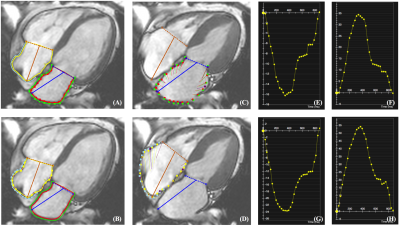
Figure 1. CMR-TT analysis of LA and RA radial and longitudinal strains (RS and LS). The location of mitral and tricuspid valves as well as the delineation of LA and RA endo- and epicardial borders were performed at end-diastole (A, B). After the completion of tracking, the myocardial deformation at end-systole was visually presented with red and green lines for LA (C), and yellow and blue lines for RA (D). Meanwhile, the strain-time curves of LARS (C), LALS (D), RARS (G) and RALS (H) were generated directly by CMR-TT modality.
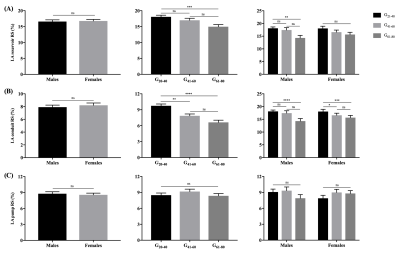
Figure 2. Gender- and age-related differences of LA reservoir RS (A), conduit RS (B) and pump RS (C). *P<0.05, **P<0.01, ***P<0.001, ****P<0.0001: age-related difference; ns: not significant.
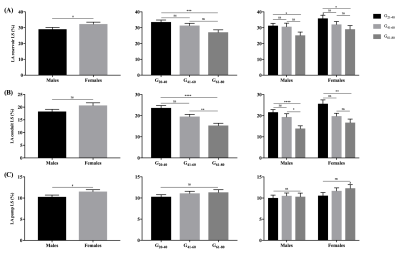
Figure 3. Gender- and age-related differences of LA reservoir LS (A), conduit LS (B) and pump LS (C). #P<0.05: gender-related difference; *P<0.05, **P<0.01, ***P<0.001, ****P<0.0001: age-related difference; ns: not significant.
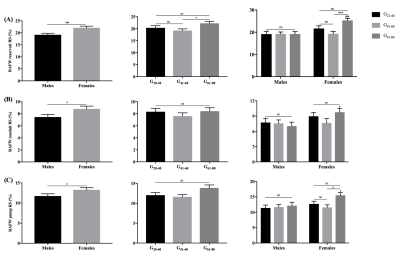
Figure 4. Gender- and age-related differences of RAFW reservoir RS (A), conduit RS (B) and pump RS (C). #P<0.05, ###P<0.001: gender-related difference; *P<0.05, ***P<0.001: age-related difference; ns: not significant.
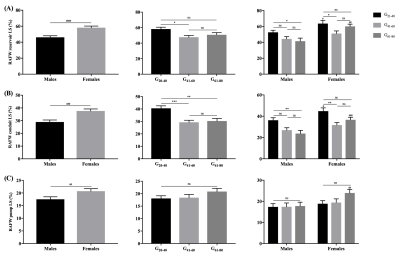
Figure 5. Gender- and age-related differences of RAFW reservoir LS (A), conduit LS (B) and pump LS (C). ##P<0.01, ###P<0.001, ####P<0.0001: gender-related difference; *P<0.05, **P<0.01, ***P<0.001; ns: not significant.